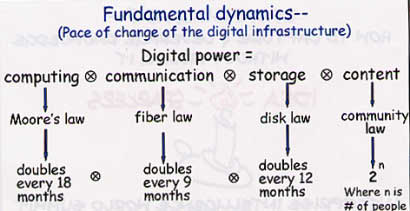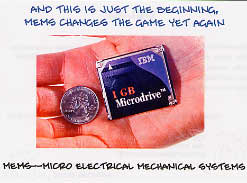|
|
Katalina Groh, Larry Prusak: Some of the world's leading thinkers |
| Storytelling: Scientist's Perspective: John Seely Brown |

The increasing pace of change I really have been struck,
working for one very large corporation, Xerox, and one very small corporation,
Twelve Entrepreneuring, how we are both faced with the same problem, that
the world is perpetually changing faster and faster.
|
 |
Now let me go back and look at the law of storage for another moment, because I think that this is really pretty astounding. I am holding before you a complete rotating disk. This comes out of my digital camera. This disk is one gigabyte of storage, complete, compact, sitting right here. What’s very interesting to me is that the rotating disk in here flying at a very fast speed, in the camera, the camera is on, and the head of the disk is actually flying one micron above this, And so in some ways the real breakthroughs are going to happen in terms not just to how you move atoms to bits, but how do you move back again, bits into into atoms, working in synchrony together. |
| And so in some ways
the real breakthroughs are going to happen in terms not just to how you
move atoms to bits, but how do you move back again, bits into into atoms,
working in synchrony together.
And in fact, I will tell you that some new work we are doing ourselves, with some other people we know, in IBM and Carnegie Mellon, is that we will be able to take this size, this up to approximately one thousand gigabytes, in say, five to eight years. So that is faster than the law of storage. Now why do I say this? I say it because we now have to start thinking about a whole new game, thinking about your telephone, your Palm, your cell phone, carrying literally everything you have ever done, with you, every movie you have ever seen, every book you’ve ever read, every paper you have ever read or written, is something with you. But what this suggests is that the whole world of wireless communication is going to be triple-charging knowledge into your knowledge store that you carry around with you. So you have your world with you. And this starts to change an awful lot of things. And I think that it behooves us to think through some of this, because I believe that an awful lot of the architecture on which we build our systems today don’t quite understand just what the power of this really means, when we start to carry these things. By the way, the kind of storage we are now talking about will be about the same size and will require virtually no power. So you really will be able to carry this around. It needs almost no batteries at all. With all this change, as I stated just a moment ago, change is going to keep being with us, it does suggest, and one of the reasons that we are all here today, is that the key to survival, maybe the only place where you can get a sustainable edge in the enterprise that you are in, or the industry, has to do with how you learn faster than your competitor. How do you share those learnings more rapidly, within your firm, how do you in fact engage in agile experimentation, and reflection. The reason I put in reflection and some of you can already tell where I am headed, is that communities of practice could turn into very powerful entities for reflective practice and we will come back to that. |
| Books and videos on storytelling *** In Good Company : How Social Capital Makes Organizations Work by Don Cohen, Laurence Prusak (February 2001) Harvard Business School Press *** The Social Life of Information, by John Seely Brown, Paul Duguid (February 2000) Harvard Business School Press *** The Springboard : How Storytelling Ignites Action in Knowledge-Era Organizations by Stephen Denning (October 2000) Butterworth-Heinemann *** The Art of Possibility, a video with Ben and Ros Zander : Groh Publications (February 2001) |
| The views expressed on this website are those of the authors, and not necessarily those of any person or organization |
| Site optimized in 800x600: webmaster CR WEB CONSULTING |
|
|
|
|